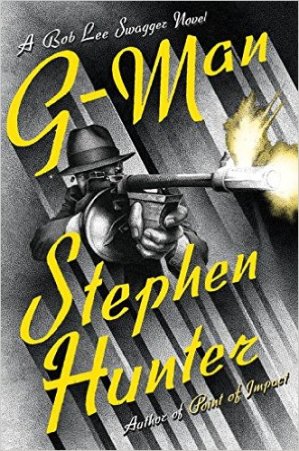
As Bob Lee Swagger’s story continues in Stephen Hunter’s G-Man, the author takes readers back in time to explore the secret life of Swagger’s granddad, Charles Swagger.
After selling his family home in Arkansas, which had been Swagger-owned for many generations, Bob Lee settles into retirement and looks for his next challenge in life. His wife suggests he write a book, but as the legendary sniper considers penning his memoir, he gets a call from the family attorney that puts everything on hold.
It turns out that the people who bought Swagger’s Arkansas property found a locked metal box that had been buried deep underground. Swagger listens as his lawyer explains that inside the box, several questionable items were found. Among them are a thousand dollar bill, an FBI badge, a government-issued Colt .45 handgun, which had been wrapped in cloth and preserved, and what appears to be a hand-drawn map.
Swagger doesn’t know what to make of the box or its contents, which are eventually traced back to the 1930s. Subsequently, he begins an investigation into the life of his grandfather, Charles Swagger, hoping to find answers to his questions.
Readers learn Charles Swagger’s story right along with Bob Lee, who never knew much about his grandfather. In fact, all he knew was that his grandpa was a World War I hero and he’d lived in Arkansas. That’s about it.
It turns out that Bob Lee was hardly the only expert marksman to come from the Swagger family gene pool. Before him, Charles was quietly known as a world-class shooter, which, Bob Lee learns, was the reason why his grandad was secretly recruited away from his post as Polk County Sheriff before joining the FBI and relocating from Arkansas to Chicago.
The book alternates back and forth between the 1930s, following Charles Swagger as he leads several FBI manhunts, and the present day, where Bob Lee tries to piece together his grandfather’s past.
Officially, there is no record of Charles Swagger working for the FBI, or their Chicago office. Unofficially, he was brought in to train new agents and head up several investigations of numerous high-profile bank robberies, chasing real-life criminals like John Dillinger, Pretty Boy Floyd, Bonnie and Clyde, and Baby Face Nelson.
Of them all, Baby Face Nelson (real name Les Gillis) was the most dangerous. And the scene involving his infamous shootout with FBI agents back in June of 1934 is especially riveting. It’s one of several white-knuckle action sequences, which are expertly written.
While Bob Lee Swagger remains the series star, the best pages of G-Man are dedicated to Charles. Stephen Hunter takes readers back in time, placing them in the moment during some of the most infamous shootouts in FBI history. And while those scenes will get your adrenaline pumping, Hunter sustains the pacing by throwing in several twists along the way for Bob Lee, who soon learns that he’s not the only one trying to uncover the truth about his grandfather’s past.
As always, Hunter nails even the smallest of details when it comes to firearms. Everything from how different guns work, right down to how they feel in the shooter’s hands are expertly explained. The authentic descriptions of touch and feel will be appreciated by gun nuts, while history buffs will get a kick out of the flashback scenes and Hunter’s dead-on, realistic dialogue.
Some readers may miss the younger days of Bob Lee, who is now an old man, but Stephen Hunter–by adding flashbacks to Charles’ gung-ho days–has found an interesting way to keep his latest story full of action. The bullets fly early and often in this one, as G-Man provides longtime fans with an in-depth look at the Swagger family’s history.
Book Details
Author: Stephen Hunter
Series: Bob Lee Swagger #10
Pages: 464 (Hardcover)
ISBN: 0399574603
Publisher: Blue Rider Press
Release Date: May 16, 2017 (Order Now!)
